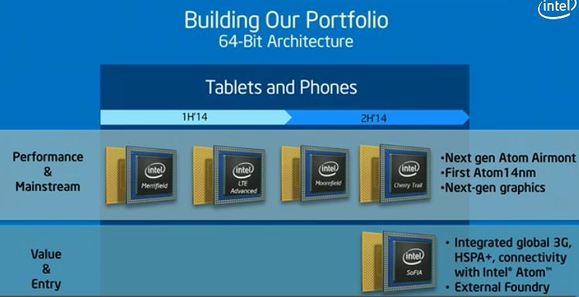Intel processors for tablets and smartphones - plans for the near future

Intel aims to increase the performance of mobile CPUs 5 times, and their graphics subsystem - 15 times in the next two years. For the sake of achieving such ambitious results, the company is reviewing the schedule for the release of the following processors for mobile devices, which became known from the Intel management presentations at a conference for investors last Thursday.
In early 2014, the first productive smartphones on a chip codenamed Merrifield will appear. The chip has 2 or 4 cores, created by 22-nm process technology. By the end of the year, it will be replaced by the Cherry Trail chip on the Airmont core with integrated graphics of the new generation - the first 14-nm Atom. In turn, the successor to Cherry Trail in early 2015 will be an even more productive and efficient Broxton chip on the Goldmont core with a fundamentally new modular design that makes it easy to add additional functionality by attaching individual components to it.

For the budget segment at the end of 2014, the Sofia chip with the integrated 3G communication core will be released, which in 2015 will be replaced with the LTE core. It is emphasized that the communication core also uses x86 architecture.
')
If we compare the given plans with those previously published, it can be understood that the timing of the launch of new products has decreased, and the strategy for their promotion looks more aggressive. Even the naked eye can see that Intel is rushing to a breakthrough on the mobile front. Well, the results of this attack will be visible in the very near future.
Source: https://habr.com/ru/post/204448/
All Articles